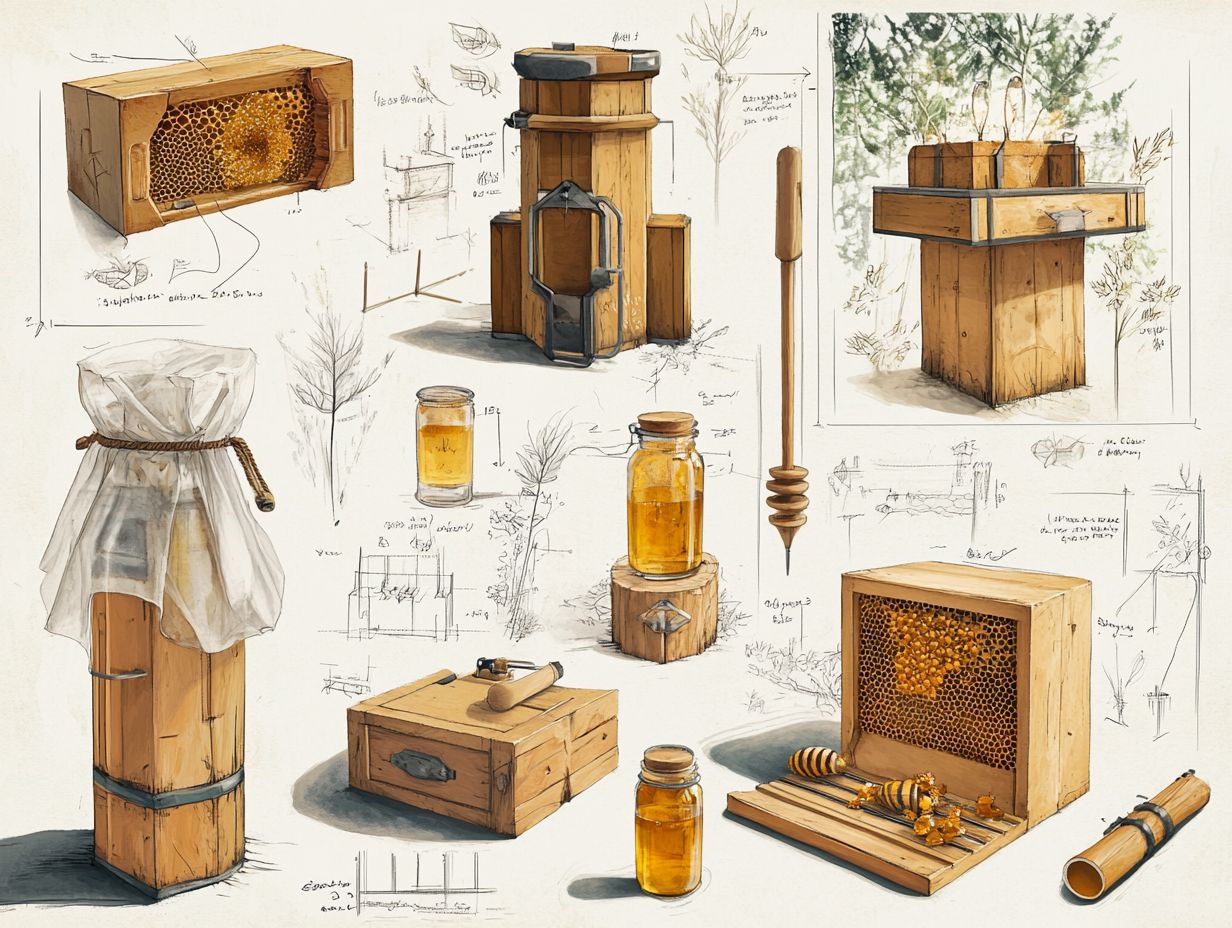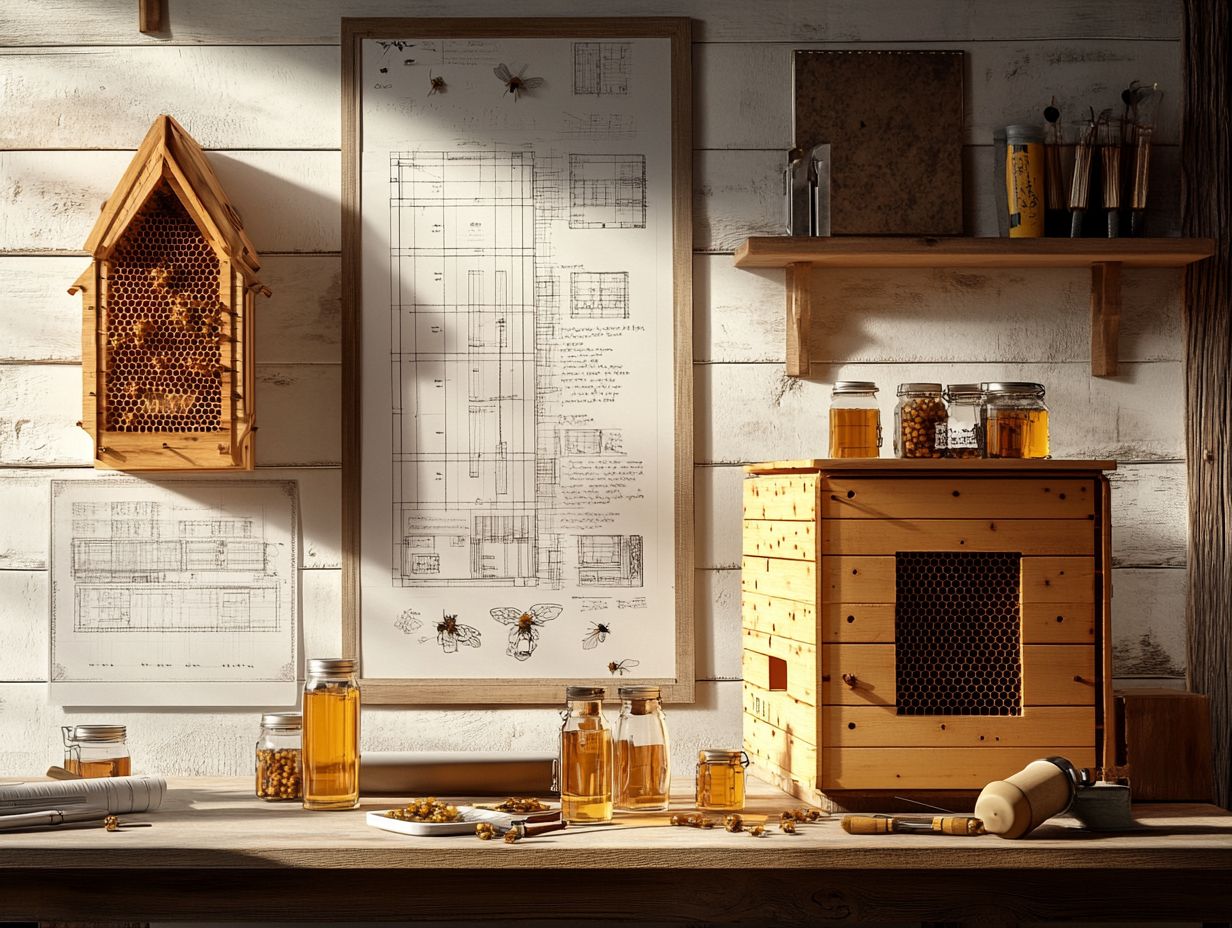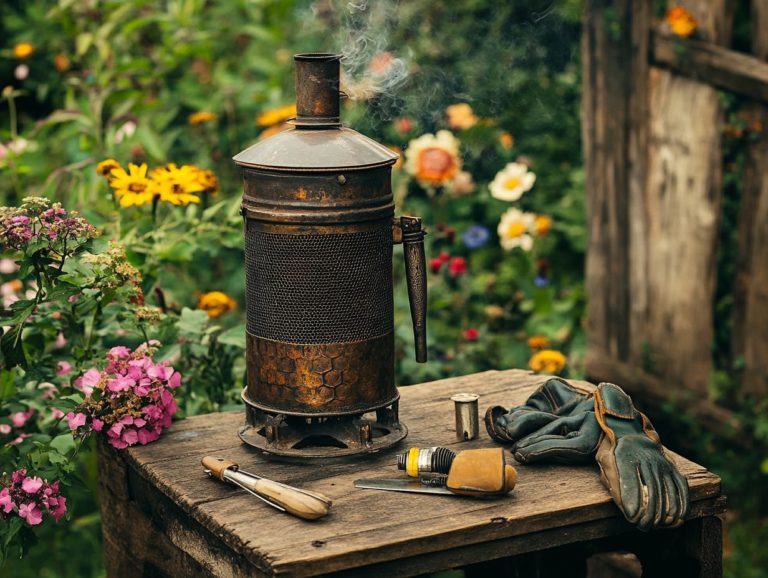Evaluating DIY Beekeeping Equipment Designs
Beekeeping can be an incredibly rewarding hobby. Crafting your own equipment adds a personal touch that enhances the entire experience.
Opting for the DIY route presents numerous advantages. These range from substantial cost savings to the flexibility of customizing your setup to suit your unique requirements.
Sustainability plays a vital role here. Using homemade equipment often diminishes your dependence on commercial products.
You’ll explore essential considerations when evaluating DIY designs. We’ll highlight popular hive types and weigh the pros and cons of each. This approach will help you make informed decisions as you embark on your beekeeping journey.
Contents
- Key Takeaways:
- Why Consider DIY Beekeeping Equipment?
- Factors to Consider when Evaluating DIY Beekeeping Equipment Designs
- Popular DIY Beekeeping Equipment Designs
- Pros and Cons of Each Design
- Frequently Asked Questions
- What factors should I consider when evaluating DIY beekeeping equipment designs?
- How can I determine if a DIY beekeeping equipment design is suitable for my bees?
- What are the benefits of using a DIY beekeeping equipment design?
- How important is durability when evaluating DIY beekeeping equipment designs?
- What are some common mistakes to avoid when evaluating DIY beekeeping equipment designs?
- Can I modify existing DIY beekeeping equipment designs to better suit my needs?
Key Takeaways:
Why Consider DIY Beekeeping Equipment?
Understanding the reasons for opting for DIY beekeeping equipment is crucial for both novice and experienced beekeepers.
DIY solutions not only provide impressive cost savings compared to commercially produced hives. They also enable you to customize your equipment to suit your specific beekeeping needs.
Crafting your own beekeeping gear also helps the environment. It promotes a healthier environment for honey bees and enhances the performance of your colonies.
1. Cost Savings
Cost savings stands out as one of the most compelling reasons for you to consider crafting your own beekeeping equipment. This approach allows you to spend money on crucial areas like a breeding stronger bees or helping your bees thrive.
When you compare the costs of DIY equipment to commercial alternatives, the differences can be striking. For instance, purchasing a ready-made hive might set you back hundreds of dollars. On the other hand, sourcing materials and assembling it yourself could slash those costs by up to 50%.
This savings means you can invest in exciting new projects for your bees! Breeding initiatives can bolster essential traits such as disease resistance and hygienic behavior within your colonies. By reinvesting these savings, you can significantly improve the overall health and productivity of your hives, fostering a more sustainable beekeeping practice in the long run.
2. Customization
Customization in DIY beekeeping equipment enables you to create setups specifically tailored to the unique needs of your honey bees. This enhances their overall health and productivity.
By adapting designs to accommodate the varying environmental conditions you face, you can ensure that your hives are well-equipped to withstand local weather patterns. This reduces stress on your colonies.
Customizing your equipment also paves the way for improved breeding stocks. You can select bees that exhibit desirable traits such as increased honey production or enhanced disease resistance.
This personalized approach maximizes your honey yields and fosters a balanced ecosystem. Healthier bees contribute to improved pollination in the surrounding environment. Ultimately, these tailored modifications enable you to take proactive steps toward maintaining vibrant and sustainable apiaries.
3. Sustainability
Sustainability is essential in the world of DIY beekeeping. It allows you to implement practices that benefit both your bees and the environment.
By prioritizing eco-friendly materials, you can create hives that are gentle on the surrounding ecosystem and the bees themselves. For instance, opting for untreated wood or natural finishes minimizes chemical exposure, fostering healthier bee colonies.
Utilizing organic methods for pest management significantly reduces the toxins that can threaten bee populations. These mindful choices can lead to stronger, more resilient communities of honey bees, enhancing their genetic diversity over time.
Embracing sustainable practices not only nurtures your bees but also contributes to a more balanced environment for all living organisms. Join the DIY beekeeping revolution!
Factors to Consider when Evaluating DIY Beekeeping Equipment Designs
When you evaluate DIY beekeeping equipment designs, key factors that can make or break your beekeeping success come into play. These factors can significantly influence the effectiveness of your honey bee colonies.
Key elements to consider include the materials used, the ease of construction, durability, and overall functionality. Each of these aspects plays a vital role in ensuring your beekeeping venture thrives.
1. Materials Used
The materials you choose for DIY beekeeping equipment are vital for the longevity and effectiveness of your honey bee colonies. When you opt for high-quality wood or durable plastics, you’re not just ensuring that your hives can brave various environmental stressors.
You’re also making a significant contribution to the overall health and productivity of your bees. Using superior materials enhances insulation, helping to minimize temperature fluctuations that could otherwise leave your bees vulnerable to diseases, such as American Foulbrood, a disease that affects bee larvae.
By selecting treated wood, you can guard against rot and pests infiltrating your hives. This reduces maintenance needs and boosts the chances of successful honey production.
Thus, making informed choices about materials is essential for nurturing resilient and thriving bee populations.
2. Ease of Construction
Ease of construction is a vital consideration in DIY beekeeping, particularly for those just starting out. Beginners may find themselves navigating the complexities of creating suitable environments for honey bee colonies.
When the designs are straightforward, you can quickly set up your hives. This alleviates the intimidation factor that often accompanies this rewarding hobby.
This simplicity not only encourages you as a first-time beekeeper to take the plunge but also significantly bolsters broader participation in programs to improve bee health.
By making beekeeping more accessible, you open the door for a wider audience to contribute to enhancing genetic diversity within bee populations, which is essential for their resilience. Easy designs welcome more people into beekeeping, creating a vibrant community of enthusiasts!
3. Durability
Durability is essential in DIY beekeeping equipment, as it must withstand various environmental conditions to support the long-term health of honey bee colonies. When you invest in robust designs, you enhance the operational lifespan of your hives.
Reliable equipment reduces the frequency of repairs and replacements, ultimately cutting down on the maintenance costs that honey producers often encounter. This financial benefit allows you to direct resources toward improved management practices, thereby strengthening the resilience of your colonies.
With a more stable environment and fewer disruptions from equipment failures, your bees can more effectively fend off diseases and pests—key factors in maintaining their health and productivity.
4. Functionality
The functionality of your DIY beekeeping equipment plays a crucial role in the health and productivity of your honey bee colonies, making it an essential aspect of your design considerations.
When crafting such equipment, you should take into account various functional elements that can significantly enhance the efficiency of your beekeeping process. For instance, ensuring proper ventilation within the hive is vital; it helps regulate temperature and humidity levels.
This creates an environment that supports bee health. Allocating adequate space for drone production and queen rearing is equally important, as these components are key to maintaining the strength of your colony.
By thoughtfully incorporating these features, you can facilitate effective breeding techniques, resulting in thriving hives that yield abundant honey while also supporting ecological balance.
Popular DIY Beekeeping Equipment Designs
Among the esteemed DIY beekeeping equipment designs, the Top Bar Hive, Warre Hive, and Langstroth Hive emerge as exceptional choices. Each design is adept at fostering the health and productivity of honey bee colonies.
Dive into these designs today and start your journey to becoming a successful beekeeper!
1. Top Bar Hive
The Top Bar Hive stands out as a favored option in the realm of DIY beekeeping, thanks to its simplicity and effectiveness in managing honey bee colonies.
With its straightforward design, you’ll find it easy to construct, often using materials that are readily available. This significantly lowers the barrier to entry, welcoming newcomers into the fascinating world of beekeeping.
The hive fosters healthier honey bee populations by allowing them to engage in natural behaviors, like building honeycomb at their own pace. This ultimately reduces stress on the bees.
The design of the Top Bar Hive is perfect for choosing the best bees to breed. It provides optimal conditions for you to observe and cultivate desirable traits in your bee populations, such as honey production and resistance to disease.
This makes it an invaluable tool, whether you’re an amateur enthusiast or a seasoned professional apiarist.
2. Warre Hive
The Warre Hive embodies a sustainable approach to DIY beekeeping, encouraging minimal interference with honey bee colonies while nurturing their natural behaviors.
This distinctive design enables bees to construct their own comb, aligning with their instinctive needs. It fosters a more resilient colony.
With its vertical structure, the hive promotes effective clustering, enabling bees to better regulate temperature and humidity.
This setup boosts colony performance and supercharges breeding capabilities! Your bees will thrive like never before!
By allowing for less human intervention, bees can naturally select for desirable traits like disease resistance and hygienic behavior, leading to healthier populations overall.
Embracing these principles allows you, as a beekeeper, to cultivate a more harmonious relationship with nature while nurturing thriving, self-sufficient colonies.
3. Langstroth Hive
The Langstroth Hive is a timeless classic that has proven itself over the years, providing you with a dependable structure for managing your honey bee colonies.
This innovative design features removable frames, making it easy for you to inspect and monitor the health and productivity of your bees.
Its modular structure simplifies performance evaluation, enhancing your ability to manage swarming behavior, leading to a more successful honey yield.
These hives support effective breeding techniques, significantly improving genetic diversity within your colony.
The adaptability of the Langstroth design is a vital asset in fostering disease resistance and promoting sustainability in your beekeeping practices. It ensures healthier bee populations for the future.
Pros and Cons of Each Design
Grasping the advantages and disadvantages of each DIY beekeeping design—be it the Top Bar Hive, Warre Hive, or Langstroth Hive—can profoundly influence your decisions as a beekeeper. This knowledge ultimately helps you maintain thriving honey bee colonies.
1. Top Bar Hive
The Top Bar Hive presents several advantages for you, particularly in terms of ease of access during inspections. However, it also comes with drawbacks that you should carefully consider.
This hive design encourages more natural bee behaviors, enhancing the overall health of the colony and reducing stress levels among your bees.
While its simplistic nature may be a godsend for novice beekeepers, you might find the open structure poses challenges when it comes to pest management.
For example, this type of hive can be more vulnerable to common issues like Varroa mite infestations. This necessitates vigilant monitoring and timely intervention on your part.
Additionally, the unique way bees construct their combs in a Top Bar Hive can significantly impact your breeding practices. Depending on how you manage the hives, this could lead to either increased genetic diversity or potential weaknesses within your colonies.
By understanding these factors, you can make well-informed decisions regarding hive selection that align with your beekeeping goals.
Explore these hive designs today and start your beekeeping journey!
2. Warre Hive
The Warre Hive garners admiration for its sustainable practices and low-maintenance approach. However, it may not align perfectly with every beekeeper’s requirements.
This hive fosters natural bee behaviors and allows colonies to flourish with minimal interference. Yet, the vertical design might present challenges for those accustomed to horizontally oriented hives.
If you prioritize rapid honey harvesting, you might find the Warre Hive less advantageous, as it emphasizes colony health over immediate extraction.
Its construction encourages bees to build their own comb, which is excellent for nurturing robust colonies. However, this could complicate breeding programs focused on specific traits. Understanding these dynamics is essential to determine whether the Warre Hive fits your goals and current practices.
3. Langstroth Hive
The Langstroth Hive stands out as a prominent choice in the beekeeping world. It is celebrated for its easy customization and efficiency, presenting a unique blend of advantages and disadvantages.
As a beekeeper, you’ll appreciate the convenience of its removable frames. They provide easy access to both bees and honey, simplifying management and inspections. This design supports practices like honey extraction and queen rearing, while also creating an organized environment for monitoring the health of your colony.
However, the fixed frame design can pose challenges in space regulation, potentially leading to crowding or swarming if not managed correctly. For beginners, the initial setup might feel intimidating, which could affect your confidence in handling the colonies.
Ultimately, the effectiveness of the Langstroth Hive in managing breeding stock and assessing performance will hinge on your experience and adaptability in the craft.
Frequently Asked Questions
What factors should I consider when evaluating DIY beekeeping equipment designs?
When evaluating DIY beekeeping equipment designs, consider the following factors:
- Materials
- Cost
- Functionality
- Durability
Also think about the specific needs and preferences of your bees, as well as your skill level and available resources.
How can I determine if a DIY beekeeping equipment design is suitable for my bees?
To determine if a DIY design suits your bees, research their specific needs and behaviors. This knowledge will help you understand the necessary features and materials for their health and productivity. Consulting with experienced beekeepers can also provide valuable insights.
What are the benefits of using a DIY beekeeping equipment design?
DIY beekeeping equipment offers exciting benefits:
- Cost savings
- Customization to fit your needs
- A sense of satisfaction from creating your own equipment
- Valuable learning experience
Building your own equipment helps you better understand the needs of your bees.
How important is durability when evaluating DIY beekeeping equipment designs?
Durability is crucial when evaluating DIY beekeeping equipment. Bees can be hard on equipment, so ensuring it will hold up over time is essential. Using quality materials and proper construction techniques helps maintain the functionality of your hive.
What are some common mistakes to avoid when evaluating DIY beekeeping equipment designs?
Avoid these common mistakes:
- Using subpar materials
- Not considering the specific needs of your bees
- Failing to research or consult experienced beekeepers
- Rushing the construction process
- Neglecting regular maintenance and inspection
Take your time and ensure your equipment is in good condition for the best results.
Can I modify existing DIY beekeeping equipment designs to better suit my needs?
Yes, you can absolutely change existing DIY beekeeping equipment to fit your needs! This can include using different materials, adding or removing features, or adjusting dimensions.
Before making any changes, dive deep into researching each part of the equipment. This will help keep your bees safe and thriving!










